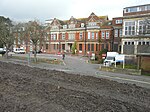Folkestone Central railway station
DfT Category C1 stationsFolkestoneFormer South Eastern Railway (UK) stationsPages with no open date in Infobox stationRailway stations in Great Britain opened in 1884 ... and 4 more
Railway stations in KentRailway stations served by SoutheasternTransport in Folkestone and HytheUse British English from August 2015

Folkestone Central railway station is on the South Eastern Main Line in England, and is the main station serving the town of Folkestone, Kent. It is 69 miles 73 chains (112.5 km) down the line from London Charing Cross. All trains that call are operated by Southeastern.
Excerpt from the Wikipedia article Folkestone Central railway station (License: CC BY-SA 3.0, Authors, Images).Folkestone Central railway station
Cheriton Road, Folkestone and Hythe District Lynwood
Geographical coordinates (GPS) Address Nearby Places Show on map
Geographical coordinates (GPS)
| Latitude | Longitude |
|---|---|
| N 51.0827 ° | E 1.1697 ° |
Address
Folkestone Central Rail Station
Cheriton Road
CT19 5HD Folkestone and Hythe District, Lynwood
England, United Kingdom
Open on Google Maps








